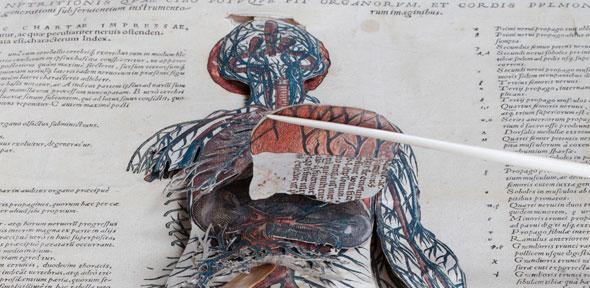
Older than the British Library and the Vatican Library, Cambridge University Library was first mentioned by name in two wills dated March 1416 and its most valuable contents stored in a wooden chest. The library now holds nine million books, journals, maps and magazines – as well as some of the world's most iconic scientific, literary and cultural treasures.
Its priceless collections include Newton’s own annotated copy of Principia Mathematica, Darwin’s papers on evolution, 3000-year-old Chinese oracle bones, and the earliest reliable text for 20 of Shakespeare’s plays.
But is also home to a bizarre assembly of non-book curiosities, collected over centuries, including a jar of ectoplasm, a trumpet for hearing spirits and a statue of the Virgin Mary, miraculously saved from an earthquake on Martinique.
Since 1710, Cambridge University Library has also been entitled to one copy of each and every publication in the UK and Ireland under Legal Deposit – meaning the greatest works of more than three millennia of recorded thought sit alongside copies of Woman’s Own and the Beano on more than 100 miles of shelves. With two million of its volumes on open display, readers have the largest open-access collection in Europe immediately available to them.
To celebrate the Library’s 600th birthday, a spectacular free exhibition, Lines of Thought, will open on March 11, 2016. Featuring some of Cambridge’s most iconic and best-known treasures, it investigates through six distinct themes how both Cambridge and its collections have changed the world and will continue to do so in the digital era.
As well as the iconic Newton, Darwin and Shakespeare artefacts mentioned above, items going on display include:
- Edmund Halley’s handwritten notebook/sketches of Halley’s Comet (1682)
- Stephen Hawking’s draft typescript of A Brief History of Time
- Darwin’s first pencil sketch of Species Theory and his Primate Tree
- A second century AD fragment of Homer’s Odyssey.
- The Nash Papyrus – a 2,000-year-old copy of the Ten Commandments
- Codex Bezae – 5th New Testament, crucial to our understanding of The Bible.
- A hand-coloured copy of Vesalius’ 1543 De fabrica – the most influential work in western medicine
- A written record of the earliest known human dissection in England (1564)
- A Babylonian tablet dated 2039 BCE (the oldest object in the library)
- The Gutenberg Bible – the earliest substantive printed book in Western Europe (1454)
- The first catalogue listing the contents of the Library in 1424, barely a decade after it was first identified in the wills of William Loryng and William Hunden
As well as Lines of Thought, 2016 will also see dozens of celebratory events including the library’s 17-storey tower being lit up as part of the e-Luminate Festival in February. Cambridge University Library is also producing a free iPad app giving readers the chance to interact with digitised copies of six of the most revolutionary texts held in its collections. The app analyses the context of the six era-defining works, including Darwin's family copy of On the origin of species, Newton's annotated copy of Principia Mathematica, and William Tyndale's translation of the New Testament into English, an undertaking which led to his execution for heresy.
From October 2016, an exhibition featuring some of the University Library’s most unusual curiosities and oddities will replace Lines of Thought as the second major exhibition of the sexcentenary.
Over the past 600 years, Cambridge has accumulated an extraordinary collection of objects, often arriving at the library as part of bequests and donations. Some of the library’s more unusual artefacts include children’s games, ration books, passports, prisoner art, Soviet cigarettes and cigars and an East African birthing stool.
University Librarian Anne Jarvis said: “For six centuries, the collections of Cambridge University Library have challenged and changed the world around us. Across science, literature and the arts, the millions of books, manuscripts and digital archives we hold have altered the very fabric of our understanding. Thousands of lines of thoughts run through them, back into the past, and forward into tomorrow. Our 600th anniversary is a chance to celebrate one of the world’s oldest and greatest research libraries, and to look forward to its future.
“Only in Cambridge, can you find Newton’s greatest works sitting alongside Darwin’s most important papers on evolution, or Sassoon’s wartime poetry books taking their place next to the Gutenberg Bible and the archive of Margaret Drabble. Our aim now, through our Digital Library, is to share as many of these great collections as widely as possible so that anyone, anywhere in the world, can stand on the shoulders of these giants.”
In 2016, Cambridge University Library will celebrate 600 years as one of the world's greatest libraries with a spectacular exhibition of priceless treasures – and a second show throwing light on its more weird and wonderful collections.

The text in this work is licensed under a Creative Commons Attribution 4.0 International License. For image use please see separate credits above.
